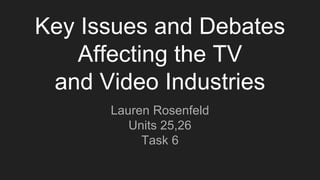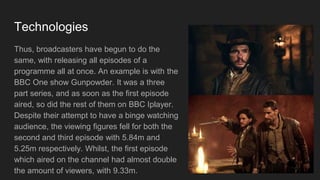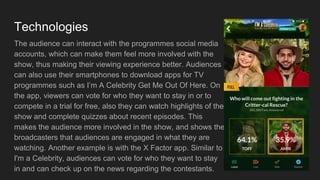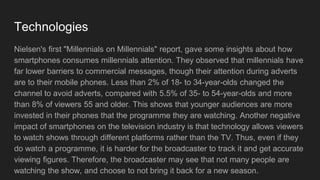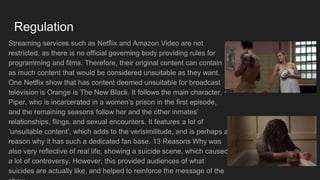Task 6 (1)
- 1. Key Issues and Debates Affecting the TV and Video Industries Lauren Rosenfeld Units 25,26 Task 6
- 2. Rating Wars When two rival channels compete for the most viewers for a programme, it is called a rating war. One of the most recent and well known rating war, which has gone on for a while is between Strictly Come Dancing (BBC One) and The X Factor (ITV). Rating wars occur during TV prime time, which is when the highest amount of viewers are watching television. It is around 7pm to 9pm. TV channels fight to have the most viewers, so they can have the best advertisements. Companies will pay more money to have their product shown on the channel that has the largest audience, as more people will see it. Thus, the TV channel will earn more money from advertisements if they have more viewers. The advertisements are more important to commercial channels, such as ITV, as BBC cannot broadcast adverts due to them being a public service broadcaster.
- 3. Rating Wars However, ratings are just as important to the BBC, as it justifies the license fee and proves that audience are enjoying their content, which they are paying for. For example, in 2017 Blue Planet II had 14 million people tune in for episode one, and Strictly Come Dancing was the second most popular show with 13 million viewers. This shows the BBC that the public like the programmes, so they can keep on making new episodes. As long as the BBC keep on putting out enjoyable programmes, the public will be happy as it shows that their license fee money is being put to good use.
- 4. Rating Wars Despite this, the rating wars may be a pain for viewers, as they may want to watch two programmes live, but can’t because they are airing at the same time. While this was more of an issue in the early years, nowadays there are many different ways to watch both programmes if they clash with each other, from recording to catching up later. Although, even today the live viewing figures will drop when audiences decide to watch one thing instead of another. Therefore, to avoid this from happening broadcasters may change a programmes time slot to another, so that the most people can watch. For example, in 2003 ITV conceded in the news war and moved its flagship 'News at Ten', to a permanent later slot, after losing evening news viewers to the BBC. ITV controller of news Steve Anderson said "Going head to head with the BBC's news programme is not a situation that we can handle,"
- 5. Rating Wars Another example was in 2001, between Eastenders and Coronation Street. Eastenders added a fourth episode slot into the week, which clashed with Coronation Street. Overall, Eastenders began to have over a million more viewers on this slot, thus ITV moved Coronation Street to 7:30pm rather than 8:00pm. This allowed viewers to enjoy both programmes and neither channel lost viewers. Thus, many broadcasters try to stop this from happening, however, in 2014 both Coronation Street and Eastenders clashed due to the World Cup. Coronation Street remained stronger of the two with 7 million viewers, whilst Eastenders had 5.28 million.
- 6. Rating Wars However, the most popular rating war has been between Strictly Come Dancing and The X Factor, which both air on Saturday and Sunday nights. Previously, both shows had the same time slot, which resulted in both of them losing viewers as many people wanted to watch both, although, The X Factor was more affected. Thus, ITV moved The X Factor to a later time slot, in order to avoid this clash, and allowed viewers to watch Strictly first and then The X Factor directly after. Thus, ratings and viewing figures began to increase again for both shows. Over the last few years, Strictly Come Dancing has been gaining viewers whilst The X Factor has been losing them. For instance, in 2017 despite not starting for another two weeks, Strictly Come Dancing was clearly superior in the ratings war against The X Factor. With the first episode gaining 3 million more viewers than ITV. An average 8.8 million tuned into the BBC show on Saturday to see the 2017 contestants paired with their professional partners, while The X Factor drew in only 5.5 million viewers.
- 7. Rating War For the BBC show (Strictly), the figures peaked at 9.5 million, which made it the most-watched show on television that day. Whereas, the ITV show (X Factor) peaked at 6.8 million viewers. The episode of Strictly made it the second most successful launch ever, only falling slightly short of the 2016 series which had 9.3 million viewers. Thus, these figures show that Strictly is only gaining popularity among fans, as its original launch show in 2010 was only watched by 7.1 million. BARB is The Broadcasters' Audience Research Board that compiles audience measurement and television ratings in the United Kingdom. The viewing figures for both shows for December 2017 can be seen on the next slide.
- 8. Rating War
- 9. Technologies Technology has evolved so much in recent years that the internet and smartphones have become rivals to the traditional television, as they allow people to watch different kinds of content on several different platforms, thus deterring them from the content on television. Many people have made a switch to these technologies to watch content as it is convenient and efficient, as it gives a person the freedom to watch what they want, when and how. For instance, there are now many on demand streaming services, such as BBC Iplayer, ITV Hub and All 4, which allow audiences to watch a programme at a time they find convenient rather than a set time slot on a set day on a specific channel. There are several different platforms also available to watch the programme on, rather than just a television, such as computers, phones, tablets and game consoles.
- 10. Technologies Many of these on demand TV catch up services were only created to compete with streaming services, such as Netflix, Amazon Video and Hulu. Netflix's initial business was DVD sales and rental. In 2007, Netflix expanded its business with the introduction of streaming media, while keeping the DVD and Blu-ray rental service. The company expanded internationally, with streaming made available to 190 countries. Netflix began creating content in 2012, debuting its first series, Lilyhammer. Since then, they have several Netflix Original series’ on their online library, with 126 original series or films in 2016, more than any other network or cable channel. As of April 2018, Netflix had 125 million total subscribers worldwide.
- 11. Technologies Netflix had a huge impact on the video industry, as so many films became available to customers for a small fee each month, they no longer needed to go out and buy a physical DVD copy. Thus, DVD sales have been on the decline, with high street sales of DVDs and Blu-ray discs falling 17% to £894m in 2017, which is the first time it has fallen below the £1bn mark. Online streaming has also affected the TV industry due to the rise in binge watching. Netflix often release entire series all at once, allowing customers to watch at their own pace or binge them all at once. For instance, the hit show 13 Reasons Why, breaking a record for the highest social volume achieved by any streaming show ever, with 3,585,110 tweets about the show during its first week on Netflix. Whereas, traditional television shows are released once a week, and many people can not be bothered to wait for them to be released.
- 12. Technologies Thus, broadcasters have begun to do the same, with releasing all episodes of a programme all at once. An example is with the BBC One show Gunpowder. It was a three part series, and as soon as the first episode aired, so did the rest of them on BBC Iplayer. Despite their attempt to have a binge watching audience, the viewing figures fell for both the second and third episode with 5.84m and 5.25m respectively. Whilst, the first episode which aired on the channel had almost double the amount of viewers, with 9.33m.
- 13. Technologies Smartphones is yet another piece of technology which has had a large impact on the television industry, in both a positive and negative way. A study found that three-quarters of the British population use a second screen while watching TV, and it’s 93% for under 25s. The Google Consumer Barometer Report, was a five- year study that included 625,000 interviews with consumers around the world, and found that in the UK three in four people now use a smartphone whilst watching TV, which has doubled in five years. This may be seen as a negative thing as the audience is distracted and not paying attention to what they see on the TV screen. However, it can be seen as a positive thing to the creator of the programme, as the audience may be using social media to interact with other who are also watching the programme, creating a buzz for it, and in turn making it a more engaging experience. This is a form of active spectatorship.
- 14. Technologies The audience can interact with the programmes social media accounts, which can make them feel more involved with the show, thus making their viewing experience better. Audiences can also use their smartphones to download apps for TV programmes such as I’m A Celebrity Get Me Out Of Here. On the app, viewers can vote for who they want to stay in or to compete in a trial for free, also they can watch highlights of the show and complete quizzes about recent episodes. This makes the audience more involved in the show, and shows the broadcasters that audiences are engaged in what they are watching. Another example is with the X Factor app. Similar to I'm a Celebrity, audiences can vote for who they want to stay in and can check up on the news regarding the contestants.
- 15. Technologies Nielsen's first "Millennials on Millennials" report, gave some insights about how smartphones consumes millennials attention. They observed that millennials have far lower barriers to commercial messages, though their attention during adverts are to their mobile phones. Less than 2% of 18- to 34-year-olds changed the channel to avoid adverts, compared with 5.5% of 35- to 54-year-olds and more than 8% of viewers 55 and older. This shows that younger audiences are more invested in their phones that the programme they are watching. Another negative impact of smartphones on the television industry is that technology allows viewers to watch shows through different platforms rather than the TV. Thus, even if they do watch a programme, it is harder for the broadcaster to track it and get accurate viewing figures. Therefore, the broadcaster may see that not many people are watching the show, and choose to not bring it back for a new season.
- 16. Technologies Smartphones also have a negative impact on the television industry, as everything audiences need are now on their phones. For instance, the news. There are several news apps and websites available to look at, thus audiences do not need to wait to see it when it airs on television at 1pm, 6pm or 10pm. There is also ease of access for audience by using a phone, as with a television, they would need to get to a TV, turn it on and scroll through the channels to find it.
- 17. Technologies One off the biggest, if not the biggest issue surrounding the television and video industries nowadays is piracy, which is the unauthorized use or reproduction of another's work, such as a TV programme or film. If a TV show has already aired in another country, such as the US, and audience from the UK have already streamed it online, then they will be less likely to watch it again when it is broadcasted on a UK channel. Thus, the broadcaster may see that not many people are interested in watching the programme, and stop paying for it. For example, Sky 1 air the CW shows Flash, Arrow & Legends of Tomorrow, six weeks later than when it is aired in the US. Therefore, UK audiences may have already watched the episode online weeks ago and do not want to watch it again. Piracy affects the video industry, as if everything's online and free, they will not want to buy the programmes DVD.
- 18. Technologies The most pirated show in recent years has been Game of Thrones. The most recent season - the seventh was pirated 1.03 billion times as of Sept. 3, according to a recent report by the anti- piracy analyst firm MUSO. They showed that more people watched the show illegally than legally on HBO. The season seven premiere had a record-breaking legal viewership of 16.1 million viewers who watched the show either live or later on HBO’s streaming platform. However, in comparison to illegal downloads or streams, there were 187.4 million viewers, which is more than 10 times the legal viewers. The season finale was the most- watched episode ever, being watched 16.5 million times — breaking HBO’s rating records. Whilst it was illegally streamed or downloaded 143.4 million times.
- 19. Technologies UK broadcasters have been trying to combat piracy by airing episodes at a closer date to the US. For instance, in recent years Sky Atlantic have been airing Game of Thrones at 2am, which is a direct simulcast with the US, that is airing at 9pm. The premiere pulled in the biggest overnight audience for an episode of GoT on Sky Atlantic after 2,830,000 people tuned in to watch. It is up 30% from the launch of the 2016 series. More fans stayed up to watch the programme in simulcast with the US than ever before, with the live broadcast attracting an audience of 115,000, which is the highest rating a Sky simulcast has ever received. Sky Atlantic have also began to do the simulcast with another HBO show - Westworld.
- 20. Technologies The piracy happened very quickly, with the season seven premiere,illegally downloaded and streamed more than 90 million times within three days of it airing. The finale, meanwhile, was pirated more than 120 million times in the same time period following its airing. The second-most pirated episode was the sixth, after it was leaked by HBO Nordic when they accidentally aired the episode early in Spain, allowing pirates to steal the file and upload it to the Internet. Many viewers watched this episode, as they wanted to know what happened before they were legally given the chance.
- 21. Technologies In 2010, the Directors Guild of America calculated the annual cost of global piracy to American companies at $25 billion in lost sales, and 375,000 jobs lost each year. In 2006, the Motion Picture Association of America commissioned a study that found film piracy cost the U.S. economy $20.5 billion. In 2015, there were 78.5 billion incidents of piracy across all American television shows and movies. A 2015 study by ScreenFutures, a group of producers, found that the main attraction for those who streamed or downloaded illegally obtained television shows was that it was free and they weren’t afraid of being caught. They said they would probably change their behavior if they were fined or faced actual legal trouble. To try to stop piracy, HBO no longer gives the press advance screenings of the show. Paper scripts were also stopped because the network feared they could be easily leaked. Also, to try and get DVD sales up, exclusive content is released with them such as deleted scenes, extras and bloopers, which encourages audiences to still buy them.
- 22. Regulation The Office of Communications (Ofcom), is the UK government-approved regulatory and competition authority for the broadcasting, telecommunications and postal industries of the United Kingdom. Ofcom has a wide range of powers across the television, radio, telecoms and postal industries. It has a duty to represent the interests of citizens and consumers by promoting competition and protecting the public from harmful or offensive material. Ofcom are responsible for the content shown on TV, in order to safeguard the public from scenes they may find offensive. For instance, channels can only air certain programmes at certain times of the day, which is known as the watershed. This protects children and vulnerable individuals from seeing inappropriate content. If audiences do find something inappropriate, they can contact Ofcom, who could fine the channel.
- 23. Regulation The watershed takes place from 9pm to 5:30pm, and during this time unsuitable material can be shown. Unsuitable material can include everything from sexual content to violence, graphic or distressing imagery and swearing. Ofcom does however restrict what can be shown. For instance, Coronation Street is a soap opera that tries to reflect real life and provide a sense of verisimilitude for the audience. Although, as it airs at 8:30pm, which is before the watershed, some things may not reflect real life, such as no swearing. For example, in March of this year, there were more than 200 complaints to ofcom, after the character of David Platt was drugged and sexually abused by Josh Tucker.
- 24. Regulation Streaming services such as Netflix and Amazon Video are not restricted, as there is no official governing body providing rules for programming and films. Therefore, their original content can contain as much content that would be considered unsuitable as they want. One Netflix show that has content deemed unsuitable for broadcast television is Orange is The New Black. It follows the main character, Piper, who is incarcerated in a women’s prison in the first episode, and the remaining seasons follow her and the other inmates’ relationships, flings, and sexual encounters. It features a lot of ‘unsuitable content’, which adds to the verisimilitude, and is perhaps a reason why it has such a dedicated fan base. 13 Reasons Why was also very reflective of real life, showing a suicide scene, which caused a lot of controversy. However, this provided audiences of what suicides are actually like, and helped to reinforce the message of the
- 25. Audience Effect Theories - Moral Panic Theorist Stanley Cohen suggested in his book Folk Devils and Moral Panics, (1972), that a moral panic occurs when a “condition, episode, person or group of persons emerges to become defined as a threat to societal values and interests”. According to Cohen, the media, play a massive role in enforcing moral panic. The message can create hate and fear in the public, and can turn them against a group of people. Moral panics are often created during the news, as if the audience is anxious about what they’ve seen, they likely will want to tune in again to see the latest development on the story. For example, the BBC are likely to target Russia in their news reports.
- 26. Audience Effect Theories - Moral Panic Terrorism is one moral panic that has emerged over the last few decades. It is now linked to terrorist groups, such as ISIS and Al Qaeda. The percentage of news involving not only terrorism but also other non-terrorist threats increased significantly after September 11, and the media’s influence concerning terrorism has affected the “openness” to immigration. The media has established an ‘anti-immigrant’ image around the world, and immigrants have been stereotyped on the news and films for years. The media tends to represent groups of people in ways that are largely consistent with the broader view of the public, and the negative portrayal of immigrants has sparked prejudice views. Channel 4’s documentary on Immigration (Immigration Street), set on a diverse street in Southampton was a close look on the impact
- 27. Audience Effect Theories - Encoding/Decoding Stuart Hall’s Encoding / Decoding Theory suggests that audience derive their own meaning from media texts. These meanings can be dominant, negotiated or oppositional, and a moral panic can be created. Soap operas such as Eastenders and Coronation Street do this most effectively for the audience, due to the realistic setting and character. Thus, if there is a sense of verisimilitude, the dominant reading will be taken. For example, the soaps may show youths who are in gangs on bikes, drinking, smoking and creating havoc in the community. The audience seeing this, most likely the older generations, will create a moral panic and may believe that all youths are like this.
- 28. Audience Effect Theories - Uses and Gratifications Blumler and Katz Uses and Gratifications Theory (1974), is when audiences consume a form of media based on their needs. A television programme can satisfy the needs of an audience. Firstly, there is diversion, which is likely the most common reason why audiences will watch a programme. This is where audiences consume media to escape their everyday life and immerse themselves in another world. For example, Game of Thrones is set in a fantasy world - Westeros, and is filled with mythical creatures. Audiences can leave the real world and imagine they are in Westeros when watching. Personal relationships is where audiences substitute a real life relationship for one on screen, and experience emotions and social interaction with characters. For example, the show The Vampire Diaries features a brotherly relationship between Stefan and Damon Salvatore. Audiences can see this and also feel a brotherly experience with them.
- 29. Audience Effect Theories - Uses and Gratifications Personal identity is where audiences try to identify with characters in a show, which can help them to define themselves. For example, The Walking Dead features a range of different characters of different ages, ethnicities and sexualities. Thus, there is at least one person that everyone will be able to relate to and identify with. Lastly, there is surveillance, which is where audiences want to find out what is happening around the world, this is mostly done by watching a documentary. For example, Blue Planet, which is filmed is a variety of locations, including Mexico’s Sea of Cortez, New Zealand and Japan. This programme informs audiences of what’s happening around the world, providing them with new information, thus encouraging viewers to watch.
